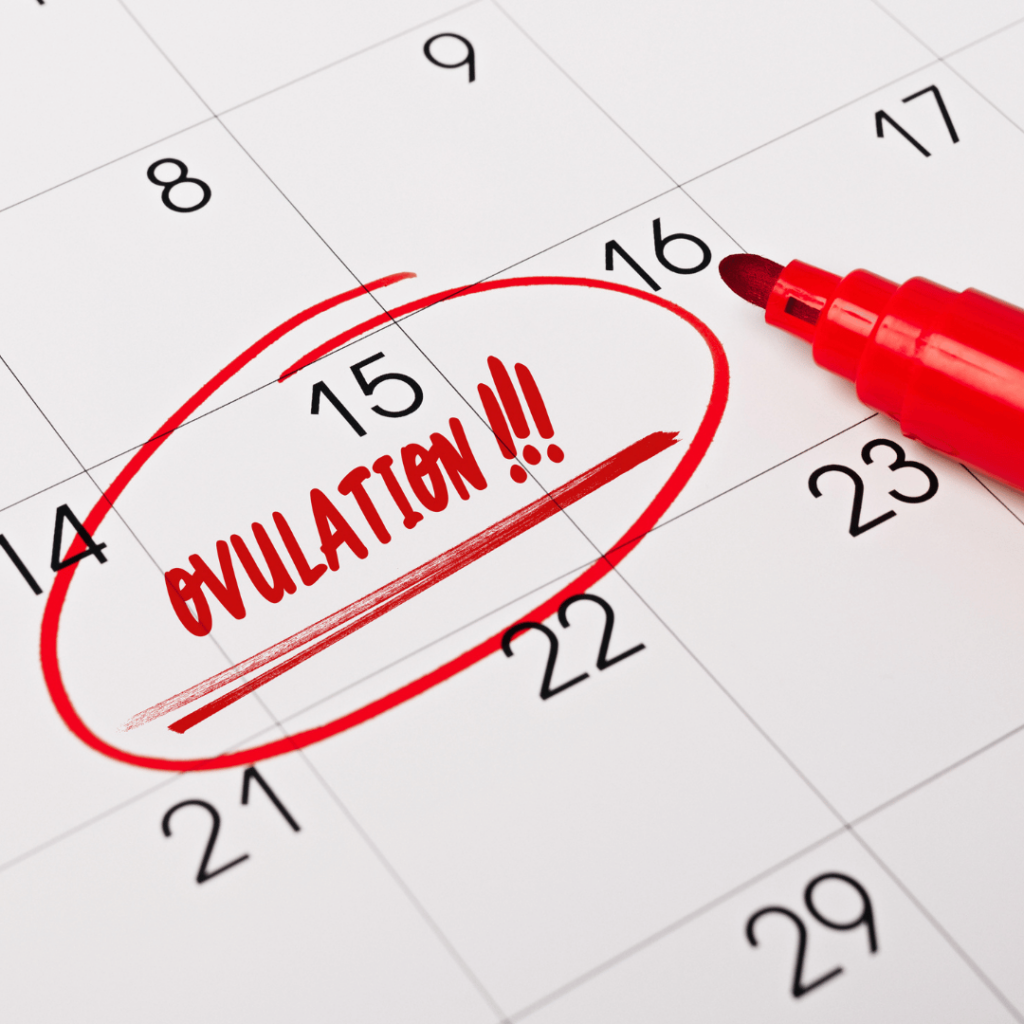Are you trying to have a baby but feeling overwhelmed and unsure of when the best days are to conceive? You’re not alone. Many women find trying to understand their menstrual cycle can be confusing, leading to feelings of frustration and hopelessness.
But don’t despair! With some education on how your body works, you can increase your chances of conceiving by understanding the most fertile times in your cycle—and we’re here to help make that happen! In this guide, we’ll share critical insight into decoding your menstrual cycle so that you can determine exactly which days provide the most significant opportunity for conception.
If you need further insights or guidance at every step during this exciting journey, know that resources are always available if required. Read on – let’s go through everything together!
Explaining the Menstrual Cycle and Ovulation
Understanding your menstrual cycle is crucial when you’re trying to conceive. Your menstrual cycle counted from the first day of one period to the first day of the next, isn’t just about having a period. Most cycles are approximately 28 days long; however, a cycle can range between 21 and 35 days for adults and between 21 and 45 days for teenage girls.
The cycle is divided into two halves: the stages of follicles and lutea. On the first day of your most recent menstruation, the follicular phase starts and lasts until ovulation. This phase is all about your ovaries preparing to release an egg. It’s during this phase that follicle-stimulating hormone (FSH) is produced, stimulating your ovaries to have around 5 to 20 tiny sacs called follicles. Each follicle contains an egg, and one of these eggs will be fully grown and released during ovulation.
When an egg is realized by the ovary during ovulation, which occurs about 14 days before the beginning of your next period, it is the best time to become pregnant. This is because the egg can be fertilized by sperm for up to 24 hours after it is released. Hormones like luteinizing hormone (LH) and FSH control ovulation, and an LH surge leads to the egg’s release from the ovary.
The luteal phase follows ovulation, and during this phase, pregnancy can occur if the egg is fertilized and implants. Menstruation begins if the egg isn’t fertilized, and the cycle starts again. Understanding these different phases and how they work can be critical to increasing your chances of conceiving. If you need a visual depiction of the menstrual cycle, the American Pregnancy Association provides an in-depth chart and guide.
Determining the Best Time for Conception

Now that you know ovulation and the menstrual cycle, it’s time to determine the best days for conception. The six-day timeframe leading up to and including ovulation, known as the ‘fertile window,’ is the most likely time for conception.
This includes the five days before ovulation and the day of ovulation itself. Five days might pass while sperm are in the female reproductive system. If they are already present when the egg is released, the chances of fertilization are significantly increased.
It would help if you tracked your menstrual cycle closely to determine your fertile window. There are several methods you can use to do this:
- [Basal Body Temperature (BBT)] Your body temperature rises slightly after ovulation. By consistently recording your temperature every morning before you get out of bed, you can detect this subtle increase and determine when you’ve ovulated.
- Ovulation Predictor Kits: These kits test your urine for the hormone surge before ovulation.Keeping track of your menstrual cycle and period dates
- Cervical mucus changes: As you approach ovulation, your cervical mucus becomes elastic and transparent, much like egg whites, which help sperm swim to the egg released during ovulation.
Remember, the fertile window is a guideline, not a guarantee. Each woman’s menstrual cycle is unique and might change from month to month. Understanding your body’s signs and patterns can better predict your fertile window and increase your chances of conception. If you’re finding it difficult to track your cycle or identify your fertile window, consider seeking advice from a fertility specialist.
Tracking Ovulation through BBT Charting and Ovulation Test Kits
Basal Body Temperature (BBT) charting and Ovulation Test Kits are reliable methods to track ovulation and increase the chances of conception.
Basal Body Temperature (BBT) Charting
BBT charting involves tracking your body’s subtle temperature increase after ovulation. You need a special thermometer that can measure small temperature changes (a basal body thermometer) to do this. It’s advised to take your temperature every morning before getting out of bed and record it on a chart or an app for a few months to identify a pattern.
After ovulation, your BBT typically increases by 0.5 to 1.0 degrees Fahrenheit and stays elevated until your next period begins. This method is cost-effective and non-invasive, but it may take a few cycles to see a pattern, and factors like illness or lack of sleep can affect your BBT. The Mayo Clinic provides a comprehensive guide on BBT charting.
Ovulation Test Kits
Ovulation prediction kits, also referred to as ovulation test kits (OPKs), detect the increase (or surge) in luteinizing hormone (LH) in your urine, which occurs 24 to 48 hours before ovulation. These kits are easy to use – like peeking on the stick to test for pregnancy and wait for the indicator.
A positive result means you’re likely to ovulate in the next day or two, and this is the best time to have intercourse for conception. These kits are reasonably accurate, but factors like certain medications or health conditions can affect their accuracy. [American Pregnancy Association] offers detailed information on how to use OPKs effectively.
Remember, while tracking ovulation helps you understand your fertility patterns, it does not guarantee pregnancy. It’s always best to consult with a medical professional or, if you have one, a fertility specialist concerned about your fertility or if you’re struggling to conceive. The Society for Assisted Reproductive Technology is a helpful resource for finding fertility clinics and specialists.
Identifying Fertility Signs in Your Body

Now that you understand the basics of tracking ovulation let’s delve deeper into identifying other key fertility signs in your body. By being in tune with your body, you can better understand your fertility patterns and increase your chances of conception.
Cervical Mucus Changes: One of the most important signs to look for is changes in your cervical mucus. Just before ovulation, your body produces more clear and stretchy mucus, similar to raw egg whites. This mucus is the most fertile, enabling sperm to swim easily towards the egg. Following ovulation, mucus will thicken and become stickier. Tracking these changes can give you a good indication of your fertility window (Healthline).
Tender Breasts: Some women experience tenderness in their breasts around ovulation, which is caused by the surge of hormones in their bodies. This is another sign that you may be in your fertile window.
Light Spotting: A small amount of light spotting or discharge could be a sign that ovulation is taking place. However, not all women experience this, and if you do notice spotting, it’s always a good idea to mention it to your healthcare provider to rule out any potential issues.
Mild Pelvic Pain: Some women can feel ovulation—known as Mittelschmerz, or “middle pain”. This is a mild twinge or aching near the ovary on one side of the lower abdomen, usually in the middle of your menstrual cycle (Mayo Clinic).
Changes in Sex Drive: Some women notice that their sex drive increases during their fertile window.
Everyone’s body is different, and you might not experience all these signs. Additionally, these signs can be subtle and easy to miss if you’re not actively looking for them. Therefore, paying attention to your body and noticing any changes is essential. If you’re unsure about any of these signs or if you have any concerns about your fertility, don’t hesitate to reach out to a healthcare provider or a fertility specialist. The American Pregnancy Association offers a wealth of resources on fertility signs and getting pregnant.
Tips for Identifying Fertility Signs in Your Body
- Stay hydrated and maintain a balanced diet: Nutrition plays a significant role in reproductive health. Fertility can be improved by eating a diet rich in fruits, vegetables, lean meats, and other nutrients, such as whole grains. Drinking plenty of water ensures that your cervical mucus stays healthy, vital for fertility.
- Watch for changes in your cervical mucus: As mentioned, the texture and colour of cervical mucus can indicate your fertility window. Checking your cervical mucus regularly can help you understand your cycle better. This Healthline article offers a detailed guide.
- Track your menstrual cycle: Use a period-tracking app to monitor your monthly cycle, which can help determine your fertile window. Clue and Flo are reputable apps for this purpose.
- Document any physical changes: Note any changes like breast tenderness, light spotting, or an increase in sex drive during your cycle.
- Monitor your basal body temperature (BBT): As stated earlier, your BBT can provide clues about your ovulation. Consistent tracking over a few cycles can help identify patterns.
- Consider an ovulation prediction kit: These can be a helpful tool for identifying your LH surge, indicating impending ovulation. The American Pregnancy Association provides more information on how to use these kits effectively.
- Consult a healthcare provider: If you’re having trouble identifying fertility signs or if you have been trying to conceive without success for over a year (or six months if you’re over 35), it’s wise to consult a healthcare provider or fertility specialist. They can offer tailored guidance and solutions for treatment.
When is the Best Time for Intercourse When Trying to Get Pregnant?
As mentioned earlier, knowing your fertility signs can help pinpoint your fertile window, which is the optimal time to have intercourse when trying to get pregnant. Sperm can live inside the female body for up to five days, and the egg can be fertilized for up to 24 hours after ovulation.
Therefore, the two to three days leading up to and including the day of ovulation are considered the most fertile. Having intercourse during this timeframe can significantly increase the likelihood of conception.
You can identify these fertile days by monitoring previously mentioned signs, such as cervical mucus changes, basal body temperature, and pelvic pain. It’s advisable to have regular sexual intercourse (every two to three days) throughout your menstrual cycle, as this ensures that there is always a supply of sperm in the female reproductive tract when ovulation occurs.
Moreover, consider seeking advice from a healthcare provider or fertility expert if you have been attempting to become pregnant for a while without success. They can provide further guidance and suggest fertility treatments if necessary. For more detailed information, consider visiting the [American Society for Reproductive Medicine].
How Soon After Your Period You Can Ovulate & Release an Egg

Understanding the timing of ovulation within your menstrual cycle is vital when planning for conception. The discharge of a developed egg from the ovary typically occurs mid-cycle, usually around 14 days before your next period begins, if you maintain a regular 28-day cycle. This means that you could start ovulating a week after your period ends. However, it’s important to note that this timeframe can vary significantly among women, with some experiencing ovulation earlier and others later in their cycle.
Things such as hormonal imbalances, stress, illness, or lifestyle changes can also influence the timing of ovulation, causing it to occur earlier or later than expected. That’s why relying solely on calendar calculations may not necessarily provide an accurate ovulation prediction for all women, particularly those with irregular cycles.
For more precise identification of your ovulation dates, consider using ovulation prediction kits, tracking basal body temperature, observing changes in cervical mucus, or employing digital apps designed to track your menstrual cycle. Use these tools in conjunction with your understanding of your unique cycle to identify your fertile window accurately.
Keep in mind that seeking the advice of a healthcare provider or fertility specialist can provide additional guidance and support, especially if you’ve been trying to conceive for some time without success. They can offer personalized strategies and suggest specific fertility assessments or treatments if required.
Understanding your body and its rhythms is critical to optimizing your chances of conception. As each woman’s cycle is unique, staying patient and maintaining a balanced, healthy lifestyle is essential while navigating this journey toward parenthood.
Lifestyle Factors that Can Impact Fertility & Optimizing Chances
In terms of fertility, the lifestyle decisions you make can have a significant impact. Both positive and negative habits can influence your reproductive health and your ability to conceive. Let’s explore the critical lifestyle factors that can impact fertility.
1. Nutrition and Diet: A balanced diet rich in vitamins, minerals, and antioxidants can enhance fertility by maintaining hormonal balance and promoting good reproductive health. A range of fruits, vegetables, lean meats, and whole grains should be included. In your diet for optimal fertility benefits.
2. Physical Activity: Regular exercise can improve fertility by enhancing physical health, managing weight, and reducing stress. However, excessive physical exertion may disrupt hormonal balance, so a moderate, consistent routine is ideal.
3. Stress Management: High stress levels can affect hormonal balance and potentially disrupt ovulation and menstrual cycles. Incorporating stress-relieving practices like yoga, meditation, or mindfulness techniques can be beneficial.
4. Alcohol and Substance Use: Excessive alcohol consumption and substance use can negatively impact fertility in both men and women. It’s advisable to limit alcohol intake and avoid illicit substances when planning to conceive.
5. Smoking: Smoking significantly decreases fertility and can also lead to complications in pregnancy. It’s highly recommended to quit smoking when trying to conceive.
6. Body Weight: Both underweight and overweight conditions can hinder fertility by causing hormonal imbalances and ovulation issues. Maintaining a healthy body weight can optimize fertility.
In summary, adopting a healthy lifestyle is crucial in optimizing your chances of conception. Regular physical activity, a balanced diet, stress management, and avoiding harmful substances are critical for maintaining a healthy reproductive system. Remember, it’s always a good idea to consult a healthcare provider or fertility specialist to discuss personalized strategies for enhancing your fertility.
Common Conception Myths and Misconceptions
In the realm of fertility and conception, numerous myths and misconceptions abound, often fuelled by outdated beliefs or misinformation. Here, we aim to debunk some of the most common ones.
Myth 1: A woman can’t get pregnant during her period. While the likelihood is lower, conception can still occur during menstruation. Sperm may remain viable in a female’s body for five days. If ovulation occurs shortly after the period, pregnancy is possible.
Myth 2: Age only affects female fertility. While it’s true that female fertility decreases with age, particularly after 35, men’s fertility also declines as they grow older, albeit at a more gradual pace.
Myth 3: Frequent intercourse increases the chances of conception. Quality, in this case, is more important than quantity. Having sexual intercourse every day doesn’t necessarily increase the odds of conception. Instead, timing intercourse during the fertile window, which typically spans five days before ovulation and the day of ovulation itself, is more effective.
Myth 4: Certain sexual positions enhance the chances of pregnancy. There’s no scientific evidence to support the claim that specific sexual positions increase the likelihood of conception.
Myth 5: A healthy couple should be able to conceive within a few months. Although many couples create within the first six months of trying, not all do. Many factors, including age, overall health, lifestyle habits, and timing of intercourse, impact fertility.
Understanding the difference between fact and fiction is crucial when it comes to conception. Always consult with a healthcare provider or a fertility specialist for accurate information.
Timing Intercourse Correctly after Menstruation to Maximize Chances of Conception
Timing sexual intercourse accurately after menstruation is pivotal in maximizing your conception chances. Aiming for your fertile window, which spans five days before ovulation and the day of ovulation itself, is essential.
Finding out how long your menstrual cycle is is usually the first step. Ovulation typically occurs around the midpoint of the cycle. For a 28-day cycle, for instance, ovulation is likely around day 14.
Once you identify your ovulation day, plan to have intercourse in the five days leading to ovulation and on the ovulation day itself, this period represents your optimal fertility window.
Using ovulation prediction kits or fertility tracking apps can help pinpoint your fertile window more precisely. These tools generally indicate a surge in luteinizing hormone (LH), which precedes ovulation by about 24 to 48 hours – offering you a headstart for well-timed intercourse.
Remember, however, that each woman’s body and cycle are unique. Always consult with a healthcare provider or a fertility specialist for personalized guidance.
In essence, understanding your menstrual cycle, identifying your fertile window, and timing intercourse effectively within this window can significantly enhance your probability of conception. With the correct information and support, you can optimize your fertility journey and increase your chances of a healthy pregnancy.
Final thoughts

Understanding the menstrual cycle, ovulation, and fertility signs can help maximize your chances of successful conception. With some patience and consent focus on timing intercourse after menstruation correctly, you can increase the probability of conceiving a baby.
Additionally, living a healthy lifestyle with regular exercise and stress-reducing activities are essential components for overall health throughout pregnancy. It’s also beneficial to learn about common myths and misconceptions about fertility and gain access to accurate information about conception.
If you have any further questions or concerns regarding the menstrual cycle and maximizing chances for conception, don’t hesitate to contact your physician for professional guidance. Ultimately, there is no one-size-fits-all when it comes to getting pregnant, but taking control of your reproductive health by knowing the basics of the menstrual cycle will prepare you when trying to conceive.
If you have further questions, please comment below and tell us your thoughts. We’d love to hear from you!
FAQ
There are several methods to track your ovulation cycle effectively. One of the easiest ways is by monitoring your menstrual cycle. If your periods are regular, you can estimate the ovulation day as the midpoint of your cycle.
Another method is observing changes in your cervical mucus. As ovulation approaches, cervical mucus becomes clear and stretchy, similar to egg whites. This is a sign of increased fertility.
Basal body temperature (BBT) tracking is another effective method. Your BBT slightly increases after ovulation, so by monitoring your BBT each morning, you can detect this rise and determine your ovulation day.
There are various stages to the menstrual cycle:
Menstrual phase (day 1-5): This is when bleeding occurs, marking the start of the cycle. The uterus sheds its lining, resulting in menstrual flow.
Follicular phase (days 1-13): . During this time, follicle-stimulating hormone (FSH) stimulates the ovaries to develop a mature egg.
Luteal phase (days 15-28): Post ovulation, the follicle that released the egg changes into the corpus luteum, which thickens the uterine lining by releasing progesterone before a fertilized egg is implanted.
Understanding these stages can assist in predicting the most fertile days in your cycle. However, cycle length and phases can vary from woman to woman and cycle to cycle.
Your most fertile days, also known as your ‘fertile window’, occur in the days leading up to ovulation and on the day of ovulation. Several signs indicate you may be in your fertile window:
Changes in cervical mucus: As you approach ovulation, your body produces more translucent and pliable mucus, like the texture of egg whites. This type of mucus is perfect for sperm to move through the uterus.
Increased basal body temperature: Your basal body temperature slightly increases after ovulation. By tracking your temperature every morning, you can identify this temperature shift. However, it’s important to remember that this method shows you’ve ovulated only after it has happened.
Ovulation pain: Some women feel a slight soreness or pain in the lower abdomen on one side, known as mittelschmerz. This pain happens around the time of ovulation and can be a sign of fertility.
Ovulation Predictor Kits (OPKs) and fertility monitors: These tools measure the luteinizing hormone (LH) surge approximately 24-48 hours before ovulation, indicating a woman’s most fertile days.

